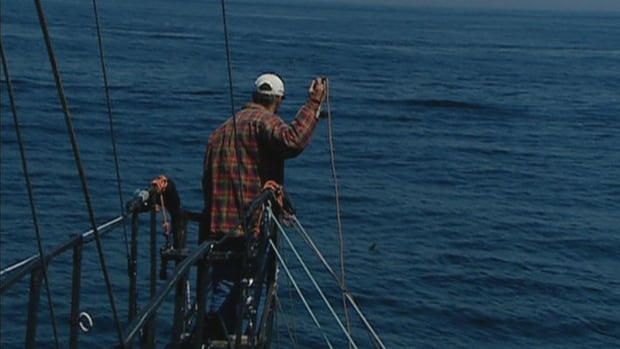For more than 20 years, Dale Richardson has walked to the end of a pulpit with a harpoon in hand to take aim at swordfish.
“It’s really an exciting fishery,” said Richardson, who lives in Shelburne County, N.S. “But due to climate change, weather conditions and so on, it’s become very difficult in the last few years to maintain our existence.”
The Ecology Action Centre says swordfish harpooning — lunging a long spear into the water to catch a fish — has become increasingly difficult and less economically viable for Nova Scotia’s commercial fleet because swordfish are appearing less often at the water’s surface.
In a report released Wednesday, the centre says changing ocean conditions are preventing fishers who use the traditional fishing method from fulfilling their already small swordfish quotas.
New gear, welcoming tourists
The group’s solution is for the swordfish harpoon fleet to use a single deepwater hook and line — called rod and reel gear — and to charge tourists to come aboard for a “thrilling, once-in-a-lifetime experience.”
Holly Isnor, marine campaign co-ordinator with the Ecology Action Centre, said rod and reel science licences have been in use in the fishery since 2022 to test out the gear. She said the single hook method is less prone to bycatch than longlining, which can entail thousands of hooks in the water for hours.
“The fish are there, they’re just not at the surface where the harpooners can find them,” Isnor said. “So adding the rod and reel and the charter options would increase their catches, increase their revenue streams and keep the sustainable fishery afloat.”
Calling on Ottawa
The Ecology Action Centre is calling on Ottawa to allow licence holders in the harpoon fishery to use rod and reel gear, and to permit them to start offering sport fishing trips.
“Collaboration is going to be incredibly important for getting this venture moving, but we really feel that this fishery can be an opportunity to showcase these means of adapting to changing conditions and looking at outside the box to keep sustainable fisheries in business,” Isnor said.
In a statement Thursday, the Department of Fisheries and Oceans said catch rates for the rod and reel method have been “very low” and next steps for the gear tests are pending.
Transport Canada, which would approve the changes to allow tourists on board, could not immediately be reached for comment.
WATCH | Swordfish are moving north in Canadian waters:
Canadian scientists and fishermen are tracking the northward movement of swordfish into Newfoundland waters where the prized fish is being caught in large numbers on the Grand Banks and Flemish Cap. Paul Withers has the story.
The centre says a licence holder could generate $61,000 a year by offering three five-day fishing trips to two passengers per season, a tourist activity that could bring in $2.5 million a year if just 25 per cent of the 184 harpoon licence holders in the Maritimes region operate charters.
“To supplement our harpoon fishery, we thought it would be great to be able to charter one or two people to go out and try and experience landing a swordfish out of the deep water,” said Richardson.
“It would help pay some of the overhead or expenses — possibly even better — and bring tourists into the region and area,” he said.
Swordfish are found in Canadian waters from spring to fall, most often near the edge of the Scotian Shelf off southern Nova Scotia and the Grand Banks of Newfoundland.
Richardson said trials of the rod and reel method resulted in above-average landings in the Grand Banks area. Since 2022, he said trials of the method have had minimal bycatch on the lines, which are about 365 metres deep.
“We just think it’s the way to go in the future,” Richardson said.
The Department of Fisheries and Oceans allocates 10 per cent — or 138.4 tonnes— of Canada’s swordfish catches per year to harpoon fishers, while the other 90 per cent is caught with longlines.








